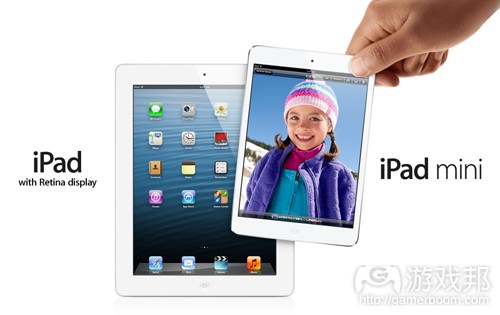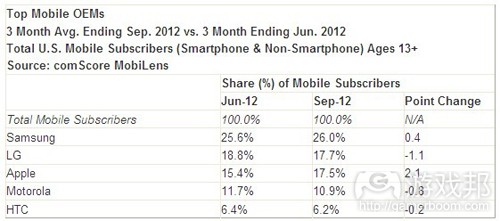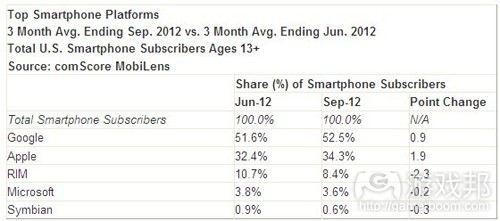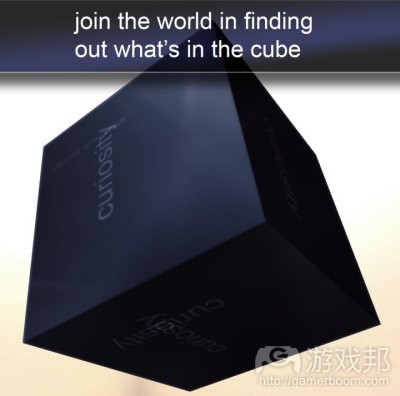每日观察:关注iPad Mini销售利润及DeNA财报等消息(11.7)
1)HIS iSuppli最近分析数据显示,每部iPad Mini制造成本为188美元,售价为329美元,这意味着苹果每售一部iPad Mini的利润率是43%;谷歌8GB的Nexus 7平板电脑成本约151.71美元,零售价为200美元,因此每部设备的利润率为24%。
2)comScore最新调查显示,第三季度(截止2012年9月)美国智能手机覆盖率首次突破50%,其中Android用户占比52.5%,苹果占比34.3%(游戏邦注:其调查样本为3万多美国手机用户),RIM占比8.4%,微软占比3.6%,Symbian占比0.6%;该季度13岁以上的美国手机用户已达2.34亿,智能手机用户总数则是1.193亿。
三星是美国头号智能手机制造商,所占市场份额达26%;位居其次的是LG,占比17.7%;苹果占比17.5%,摩托罗拉占比10.9%,HTC占比6.2%。
9月份有75.5%的美国手机用户使用短信服务(增长0.5个百分点),下载应用程序者占比54%(增长2.6个百分点),使用浏览器者占比52.6%(增长2.4个百分点),访问社交网站或博客用户占比39%(增长2.1个百分点);手机游戏玩家占比34.4%(增长1个百分点),使用移动设备听音乐的用户占比28.6%(增长1个百分点)。
3)据gamasutra报道,Capcom计划在未来10年内再招聘1000名开发者以便提升自己的游戏质量(该公司目前团队有1500名开发者)。
该公司在最近几年将大量的游戏项目开发工作外包给西方开发商,曾与Spark Unlimited合作推出《Lost Planet 3》,并同Ninja Theory联手推出《Devil May Cry》新作。但有不少外包项目备受诟病,例如出自Grin之手的《Bionic Commando》、Slant Six Games的《生化危机:浣熊市行动》。Capcom最近发行的内部开发游戏《生化危机6》也因与该系列相脱节而备受批评。
4)据insidemobileapps报道,DeNA最近公布的2012财年第三季度(截止9月30日)报告显示,该时期公司业务运营并未受到kompu gacha被取缔的严重影响,其销售额为503亿日元(6.27亿美元),营业利润为204亿美元(2.54亿美元)。
公司收益同比上年增长45%,比上季度增长3%,营业利润同比上年增长38%,比上季度增长10.8%。
该公司股票售价虽然仍未回升至全盛时期的4150日元(51.73美元),但自8月份以来仍上升了43.3%。目前其股票售价为2594日元(32.34美元),公司市值为3874亿日元(48亿美元)。
5)据insidemobileapps报道,独立工作室22Cans手机游戏《Curiosity:What’s Inside the Cube》目前已在App Store开放免费下载服务,并已向Google Play推出Android版本,但有不少用户抱怨称该游戏在安装过程存在兼容性问题。
有一项Twitter调查显示,该应用现在与大量热门设备无法兼容,其中包括摩托罗拉Xoom平板电脑,HTC的Desire、Vision和One S设备,三星的Galaxy Note以及谷歌的Nexus 7。(本文为游戏邦/gamerboom.com编译,拒绝任何不保留版权的转载,如需转载请联系:游戏邦)
1)iPad Mini earns Apple 43 per cent gross margin per unit sold
by Daniel Gumble
New tablet overpriced, you say?
With a production cost of $188 per unit and an RRP of $329, the odd cynic among us may well consider the iPad Mini just a tad overpriced.
The estimated figures, which were revealed this week by HIS iSuppli analysts, indicate that Apple stands to make a 43 per cent profit on each tablet sold.
To put that into perspective, iSuppli found that Google’s 8GB Nexus 7 has a build cost of around $151.75 and a retail price of $200, therefore yielding a gross margin of 24 per cent on each sale.(source:mobile-ent)
2)Samsung takes 26 per cent of US mobile subscribers market share
by Daniel Gumble
Smartphone penetration breaks 50 per cent mark for the first time.
comScore’s MobiLens service has reported that Samsung is the handset manufacturer of choice among US mobile subscribers, taking 26 per cent of the current market share.
Reporting key trends in the US mobile phone industry during a three-month average period, which ended on September 2012, the study surveyed over 30,000 US mobile subscribers, showing Samsung to be the leading handset manufacturer overall with 26 per cent market share.
Meanwhile, the survey also revealed that smartphone penetration has broken the 50 per cent barrier for the very first time, with Android leading that segment of the market with 52.5 per cent of smartphone subscribers, while Apple accounted for 34.3 per cent.
For a full breakdown of the reports findings, please see the figures below.
OEM Market Share
For the three-month average period ending in September, 234 million Americans age 13 and older used mobile devices. Device manufacturer Samsung ranked as the top OEM with 26 per cent of US mobile subscribers (up 0.4 percentage points), followed by LG with 17.7 percent share. Apple continued to close in on the #2 OEM ranking with 17.5 per cent of mobile subscribers (up 2.1 percentage points), followed by Motorola with 10.9 per cent and HTC with 6.2 per cent.
Top Mobile OEMs
Smartphone Platform Market Share
119.3 million people in the U.S. owned smartphones (51.0 per cent mobile market penetration) during the three months ending in September, up 8 percent since June. Google Android ranked as the top smartphone platform with 52.5 per cent market share (up 0.9 percentage points), while Apple’s share increased 1.9 percentage points to 34.3 per cent. RIM ranked third with 8.4 percent share, followed by Microsoft (3.6 per cent) and Symbian (0.6 per cent).
Mobile Content Usage
In September, 75.5 per cent of U.S. mobile subscribers used text messaging on their mobile device (up 0.5 percentage points). Downloaded applications were used by 54 per cent of subscribers (up 2.6 percentage points), while browsers were used by 52.6 per cent (up 2.4 percentage points). Accessing of social networking sites or blogs increased 2.1 percentage points to 39 per cent of mobile subscribers. Game-playing was done by 34.4 per cent of the mobile audience (up 1 percentage point), while 28.6 per cent listened to music on their phones (up 1 percentage point).(source:mobile-ent)
3)Capcom shifting away from outsourcing to improve game quality
By Eric Caoili
Capcom wants to make more of its games in-house to improve the quality of its releases, and intends to hire 1,000 developers over the next 10 years to support that goal.
The publisher has outsourced a considerable portion of its games in recent years, allowing Western developers to handle some of its biggest franchises. It’s partnered with Spark Unlimited (Turning Point) on Lost Planet 3 (pictured), and brought in Ninja Theory (Heavenly Sword) to handle its Devil May Cry reboot.
A number of those outsourced projects have been panned by critics, such as Grin’s Bionic Commando reboot and Slant Six Games’ Resident Evil: Operation Raccoon City, though the latter went on to sell over 2.1 million units worldwide.
The publisher has also received criticism recently on the quality of Resident Evil 6, an internally-developed title, which reviewers have slammed for veering too far away from the franchise’s roots, and for trying to please as many people as possible.
Capcom told investors last week that it will improve the quality of its games by creating a larger percentage of its projects internally. In order to accomplish that goal, it will add another 1,000 workers to its current team of 1,500 developers.
The publisher will focus on beefing up its content development groups for console game development, while also expanding its mobile and PC online divisions. It does not expect significant changes in its development budget, as Capcom will allocate expenditures away from outsourced projects to its internal team.(source:gamasutra)
4)DeNA’s Q2 revenues hit yet another record high, climbing 45% Y-o-Y to $627M
Kathleen De Vere•Nov 6th, 2012DeNA, Earnings, featured, Japan Japanese mobile social giant DeNA has proved it doesn’t need kompu gacha to be profitable — the company has reported its highest ever revenues, seeing sales of 50.3 billion yen ($627 million) and operating profit of 20.4 billion ($254 million) during the quarter ending on Sept. 30.
The company’s revenues are up 45 percent year-over-year and 3 percent quarter-over-quarter. Operating profit is up 38 percent year-over-year and 10.8 percent quarter-over-quarter.
DeNA’s record sales came in spite of the Japanese ban on the kompu gacha monetization tactic. A practice that heavily incentivized the purchase of randomly generated virtual goods, the crackdown on kompu gacha saw smaller Japanese mobile social gaming companies like CyberAgent and Konami report noticeably lower sales after it came into affect. DeNA gradually phased out kompu gacha from its first and third party games during May and June, so today’s earning report covers the make-or-break period where DeNA had no games using the tactic.
The results are a big win for the company and should help the company’s battered share price. Although DeNA’s shares are still down 37.4 percent from their all-time high of 4,150 yen ($51.73), prices have risen by 43.3 percent since August. The company’s shares are currently trading at 2,594 yen ($32.34), giving the company a market capitalization of 387.4 billion yen ($4.8 billion).(source:insidemobileapps)
5)Curiosity: What’s Inside the Cube (iOS/Android) review
Pete Davison
Curiosity: What’s Inside the Cube is a new mobile “social experiment” from renowned game designer Peter Molyneux’s new independent studio 22Cans. It’s available now from the App Store as a free download. The Android version is apparently available from Google Play, though many users have complained of significant compatibility issues preventing its installation. A quick and informal Twitter poll around the time of writing indicated that the app appears to be incompatible with a variety of common, popular devices including Motorola’s Xoom tablet; HTC’s Desire, Vision and One S; Samsung’s Galaxy Note; and even Google’s own Nexus 7. Molyneux’s tweets suggest that the actual, working Android version will be released later today, so check back later to see if a working version has been submitted.
Curiosity’s core concept — no pun intended — is that there is something interesting in the middle of the eponymous cube. Players from across the world will have to cooperate in order to chip off the various layers of the cube and discover what it contains. Tapping on the cube removes a single component “cubelet” from its surface, and the next layer may not be chipped away at until all of the previous layer’s cubelets have been destroyed. Whoever taps the final cubelet away will discover “what’s inside the cube,” and the eventual aim of the experiment is to study how — or if — news of the secret spreads across social media networks. The eventual goal is to implement the data acquired from Curiosity into a future game developed by 22 Cans, set to arrive in two years’ time.(source:insidesocialgames)














































 闽公网安备35020302001549号
闽公网安备35020302001549号